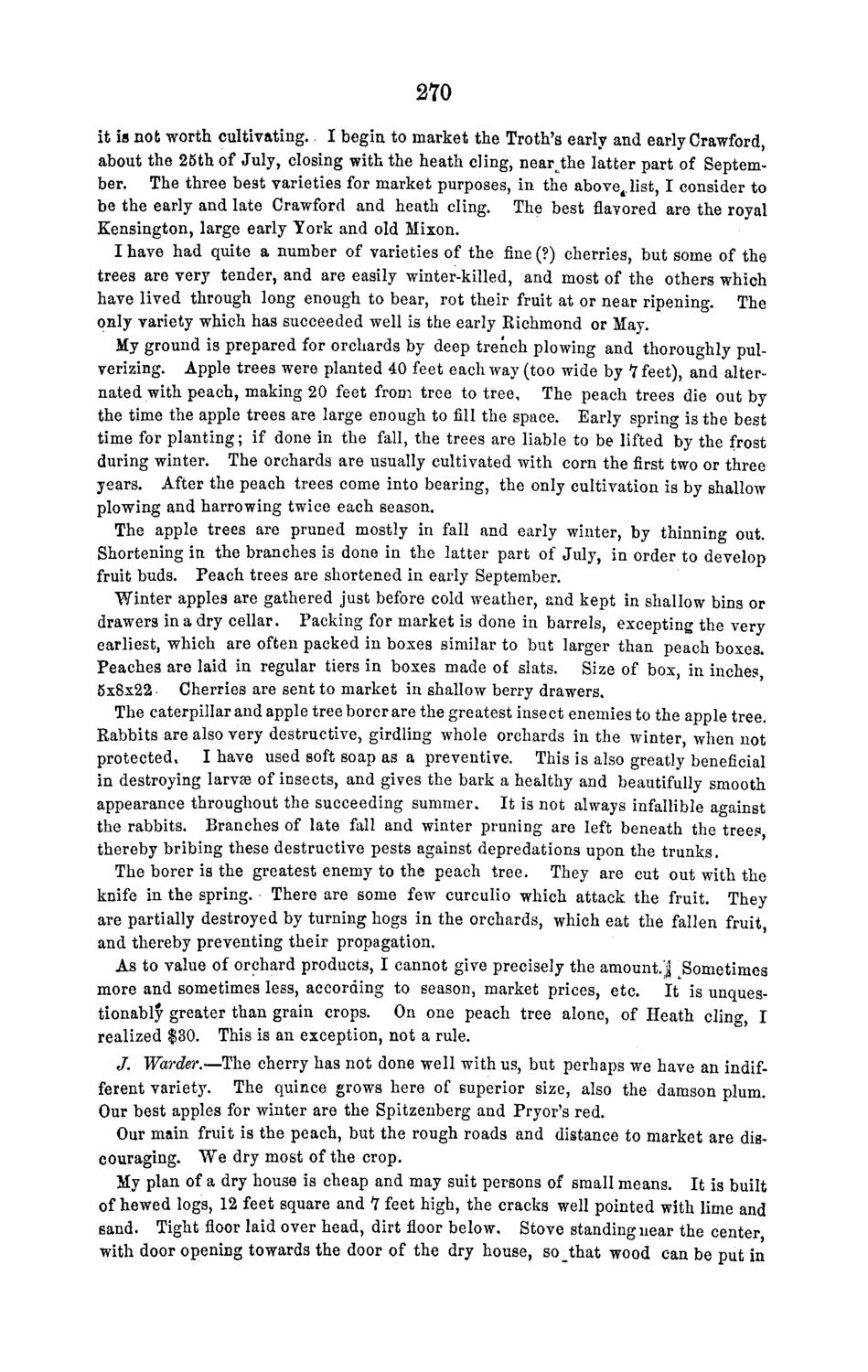| |
| |
Caption: Board of Trustees Minutes - 1868
This is a reduced-resolution page image for fast online browsing.

EXTRACTED TEXT FROM PAGE:
270 it is not worth cultivating. I begin to market the Troth's early and early Crawford, about the 25th of July, closing with the heath cling, near^the latter part of September. The three best varieties for market purposes, in the above^.list, I consider to be the early and late Crawford and heath cling. The best flavored are the royal Kensington, large early York and old Mixon. I have had quite a number of varieties of the fine (?) cherries, but some of the trees are very tender, and are easily winter-killed, and most of the others which have lived through long enough to bear, rot their fruit at or near ripening. The only variety which has succeeded well is the early Richmond or May. My ground is prepared for orchards by deep trench plowing and thoroughly pulverizing. Apple trees were planted 40 feet each way (too wide by 1 feet), and alternated with peach, making 20 feet from tree to tree. The peach trees die out by the time the apple trees are large enough to fill the space. Early spring is the best time for planting; if done in the fall, the trees are liable to be lifted by the frost during winter. The orchards are usually cultivated with corn the first two or three years. After the peach trees come into bearing, the only cultivation is by shallow plowing and harrowing twice each season. The apple trees are pruned mostly in fall and early winter, by thinning out. Shortening in the branches is done in the latter part of July, in order to develop fruit buds. Peach trees are shortened in early September. Winter apples are gathered just before cold weather, and kept in shallow bins or drawers in a dry cellar. Packing for market is done in barrels, excepting the very earliest, which are often packed in boxes similar to but larger than peach boxes. Peaches are laid in regular tiers in boxes made of slats. Size of box, in inches 5x8x22- Cherries are sent to market in shallow berry drawers. The caterpillar and apple tree borer are the greatest insect enemies to the apple tree. Rabbits are also very destructive, girdling whole orchards in the winter, when not protected, I have used soft soap as a preventive. This is also greatly beneficial in destroying larvae of insects, and gives the bark a healthy and beautifully smooth appearance throughout the succeeding summer. It is not always infallible against the rabbits. Branches of late fall and winter pruning are left beneath the trees thereby bribing these destructive pests against depredations upon the trunks. The borer is the greatest enemy to the peach tree. They are cut out with the knife in the spring. There are some few curculio which attack the fruit. They are partially destroyed by turning hogs in the orchards, which eat the fallen fruit, and thereby preventing their propagation. As to value of orchard products, I cannot give precisely the amount.| ^Sometimes more and sometimes less, according to season, market prices, etc. It is unquestionably greater than grain crops. On one peach tree alone, of Heath cling, I realized $30. This is an exception, not a rule. J. Warder.-—The cherry has not done well with us, but perhaps we have an indifferent variety. The quince grows here of superior size, also the damson plum. Our best apples for winter are the Spitzenberg and Pryor's red. Our main fruit is the peach, but the rough roads and distance to market are discouraging. We dry most of the crop. My plan of a dry house is cheap and may suit persons of small means. It is built of hewed logs, 12 feet square and 1 feet high, the cracks well pointed with lime and sand. Tight floor laid over head, dirt floor below. Stove standing near the center with door opening towards the door of the dry house, so J h a t wood can be put in
| |